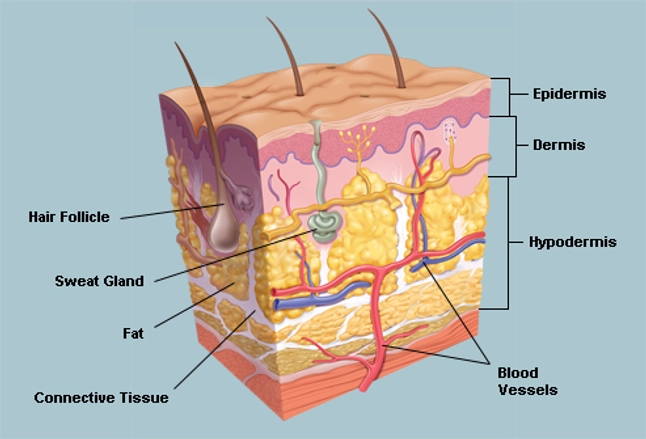Structure:
The skin is one of the largest organs in the body in surface area and weight. The skin consists of two layers: the epidermis and the dermis. Beneath the dermis lies the hypodermis or subcutaneus fatty tissue. The skin has three main functions: protection, regulation and sensation. Wounding affects all the functions of the skin.

The skin is an organ of protection. The primary function of the skin is to act as a barrier. The skin provides protection from: mechanical impacts and pressure, variations in temperature, micro-organisms, radiation and chemicals.
The skin is an organ of regulation. The skin regulates several aspects of physiology, including: body temperature via sweat and hair, and changes in peripheral circulation and fluid balance via sweat. It also acts as a reservoir for the synthesis of Vitamin D.
The skin is an organ of sensation. The skin contains an extensive network of nerve cells that detect and relay changes in the environment. There are separate receptors for heat, cold, touch, and pain. Damage to these nerve cells is known as neuropathy, which results in a loss of sensation in the affected areas. Patients with neuropathy may not feel pain when they suffer injury, increasing the risk of severe wounding or the worsening of an existing wound.
Functions:
The functions of the skin are many:
1) Skin acts as a base for sensory reception, the seat of the most delicate of the senses, touch
2) Skin is an organizer as well as an information source and processor
3) Skin acts as a mediator of the senses
4) Skin is a good barrier between organism and environment
5) Skin is an immunologic source of hormones for protective cell differentiation
6) Skin acts as a protector of underlying parts from mechanical and radiation injuries
7) Skin acts as a barrier to toxic materials and foreign organisims
8) Skin plays a major role player in regulating blood pressure and the flow of the blood
9) Skin acts as a regenerative repair organ
10) Skin acts as a producer of keratin
11) Skin is an absorptive organ of noxious and other substances, which are eventually excreted in the body's waste products
12) Skin is a temperature regulator
13) It is an organ involved in the metabolism and storage of fat, and
14) Helps in, of water and salt metabolism by perspiration
15) Skin acts as a reservoir for food and water
16) Skin acts as a respiratory organ and facilitator of the two-way passage of gases through it
17) Skin acts as the synthesizer of a number of important compounds, including the anti-rachitic vitamin D
18) Skin acts as an acidic barrier that protects against many bacteria
19) while the sebum from the sebaceous glands lubricates the skin and hair, insulates the body against rain and cold, and probably helps kill bacteria
20) Skin acts as a self cleanser.
Thank you.. for reading
Thank you.. for reading
Comments
Post a Comment